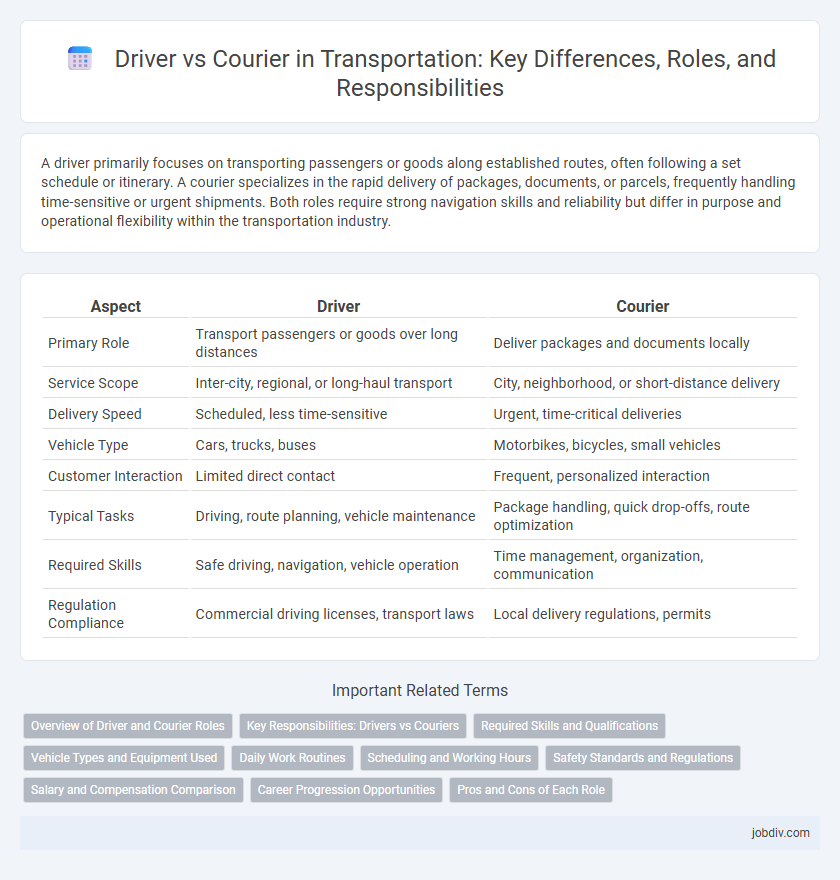A driver primarily focuses on transporting passengers or goods along established routes, often following a set schedule or itinerary. A courier specializes in the rapid delivery of packages, documents, or parcels, frequently handling time-sensitive or urgent shipments. Both roles require strong navigation skills and reliability but differ in purpose and operational flexibility within the transportation industry.
Table of Comparison
| Aspect | Driver | Courier |
|---|---|---|
| Primary Role | Transport passengers or goods over long distances | Deliver packages and documents locally |
| Service Scope | Inter-city, regional, or long-haul transport | City, neighborhood, or short-distance delivery |
| Delivery Speed | Scheduled, less time-sensitive | Urgent, time-critical deliveries |
| Vehicle Type | Cars, trucks, buses | Motorbikes, bicycles, small vehicles |
| Customer Interaction | Limited direct contact | Frequent, personalized interaction |
| Typical Tasks | Driving, route planning, vehicle maintenance | Package handling, quick drop-offs, route optimization |
| Required Skills | Safe driving, navigation, vehicle operation | Time management, organization, communication |
| Regulation Compliance | Commercial driving licenses, transport laws | Local delivery regulations, permits |
Overview of Driver and Courier Roles
Drivers primarily operate vehicles to transport passengers or freight, ensuring timely and safe delivery along designated routes. Couriers specialize in the rapid delivery of parcels or documents, often handling small, time-sensitive shipments within urban areas. Both roles require navigational skills and adherence to safety regulations, but couriers emphasize speed and direct drop-offs while drivers may manage longer distances and larger loads.
Key Responsibilities: Drivers vs Couriers
Drivers primarily focus on operating vehicles safely to transport passengers or goods over long distances, ensuring compliance with traffic regulations and maintaining vehicle condition. Couriers specialize in fast, last-mile delivery of parcels and documents within urban or local areas, often requiring efficient route planning and timely package handling. Both roles demand strong navigation skills and customer interaction, but couriers emphasize speed and precision in handling multiple small deliveries.
Required Skills and Qualifications
Drivers require a valid commercial driving license, strong knowledge of traffic laws, and excellent vehicle-handling skills to ensure safe and timely transportation. Couriers need exceptional organizational abilities, effective communication skills, and familiarity with delivery software to manage parcels efficiently. Both roles demand reliability, time management, and customer service expertise to meet transportation and delivery standards.
Vehicle Types and Equipment Used
Drivers often operate a range of vehicles including sedans, trucks, and vans primarily designed for passenger transport or large freight movement, equipped with GPS navigation, communication devices, and safety features like airbags and anti-lock brakes. Couriers typically use smaller, more maneuverable vehicles such as motorcycles, scooters, or compact cars that allow quick access through urban traffic, equipped with insulated delivery bags, portable handheld devices for scanning packages, and route optimization software. The distinct vehicle types and specialized equipment reflect the differing operational requirements between drivers focused on long-haul or bulk transportation and couriers prioritizing speed and package integrity in last-mile delivery.
Daily Work Routines
Drivers primarily focus on operating vehicles to transport goods or passengers on predetermined routes, ensuring timely and safe delivery. Couriers execute time-sensitive deliveries, often involving multiple stops, package handling, and direct customer interaction within urban areas. Both roles demand strong navigation skills and adherence to safety regulations, but couriers emphasize speed and personal service while drivers prioritize route efficiency and vehicle maintenance.
Scheduling and Working Hours
Drivers often have fixed schedules aligned with specific routes or shifts, typically working longer, continuous hours to cover extended distances. Couriers generally operate on more flexible schedules, handling multiple short deliveries with variable working hours to meet urgent or time-sensitive requests. Efficient scheduling systems optimize driver routes for fuel efficiency and time management, while courier schedules emphasize rapid turnaround and high delivery frequency.
Safety Standards and Regulations
Drivers and couriers operate under distinct safety standards and regulations tailored to their specific roles within transportation. Drivers typically adhere to commercial vehicle safety rules, including hours-of-service limits, vehicle maintenance protocols, and rigorous licensing requirements such as CDL (Commercial Driver's License) certifications. Couriers follow regulations prioritizing speed and parcel security, often incorporating GPS tracking compliance and adherence to pedestrian safety laws in urban delivery zones.
Salary and Compensation Comparison
Drivers typically earn an average salary ranging from $35,000 to $55,000 annually, depending on experience and location, while couriers often receive between $28,000 and $45,000 per year. Compensation for drivers may include benefits such as health insurance, retirement plans, and bonuses based on mileage or deliveries, whereas couriers frequently rely on hourly wages or per-delivery fees with fewer additional benefits. Geographic region, company size, and job requirements significantly influence the total compensation packages for both drivers and couriers.
Career Progression Opportunities
Drivers often begin their careers with entry-level positions that provide foundational experience in vehicle operation and navigation, leading to opportunities as commercial truck operators or fleet supervisors. Couriers typically advance by specializing in time-sensitive or high-value deliveries, progressing to roles such as logistics coordinators or regional distribution managers. Both career paths offer growth through certifications and skill development in routing technology, safety compliance, and customer service excellence.
Pros and Cons of Each Role
Drivers typically handle scheduled routes and transport passengers or goods over longer distances, offering reliability and consistency but often facing fixed routes and limited flexibility. Couriers specialize in fast, short-distance deliveries, providing agility and quick service but encountering higher pressure for time-sensitive tasks and less predictable schedules. Each role serves distinct logistical needs, with drivers favoring steadiness and couriers excelling in speed and responsiveness.
Driver vs Courier Infographic

 jobdiv.com
jobdiv.com